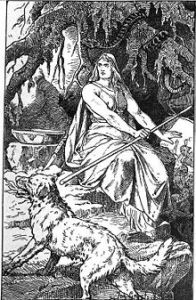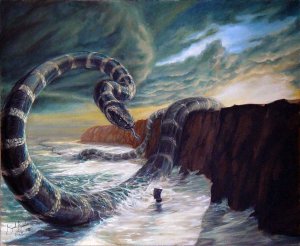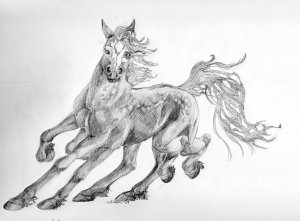In Norse mythology, Loki is a trickster god and capable of changing his shape. He is also the father – and in once case the mother – of a group of fantastical creatures, most of which play a large role in the religion of the Vikings.
HEL – Daughter of Loki and Angrbotha

Ruler of a realm that bears her name, Hel was believed to be a death goddess. To “go to Hel” was to die, specifically off the battlefield of illness or old age. The Norse believed that all those who died off the glorious field of war would be denied entry to Odin’s great feasting hall of Valhalla, and would instead freeze for all eternity in Hel.
Hel was believed to have a face split into two halves, one of them beautiful and the other hideously ugly. An enemy of Odin, Hel and her many servants were believed to fight as part of the army of Loki and the giants at Ragnarok.
JORMUNGANDR – Son of Loki and Angrbotha

Believed to be a truly colossal snake, Jormungandr (literally “Enormous monster”) lived in the great ocean that was believed to encircle Midgard – the Norse word for the world of mortals, and the middle of the nine worlds (this is where Tolkein got Middle Earth from). The snake, so the Norse believed, held the earth in place by wrapping himself all the way around it with his tail in his mouth, and when Jormungandr eventually let go the world would end.
Jormungandr was thought to have a bitter rivalry with Thor, son of Odin and god of thunder, and they encountered one another three times:
The first sees Jormungandr disguised as an enormous cat, and Thor faces with the challenge of lifting so massive a creature. The god cannot lift so gigantic a being as Jormungandr, but can lift him sufficiently high that one of his four paws leaves the ground – described by the king of the giants as an impressive achievement.
The second time Jormungandr and Thor meet, the thunder god is fishing with the giant Hymir, using the heads of oxen as bait. Jormungandr bites one of the heads, and Thor pulls him up, partially out of the water. Jormungandr, dripping in blood and venom, makes Hymir pull back in terror. As Thor prepares to kill the snake with his hammer, Mjolnir, Hymir cuts the fishing line and allows Jormungandr to slither back beneath the surface of the water.
The third and final encounter between Jormungandr and Thor occurs during Raganrok, the great final battle that ends the world. Jormungandr will finally leave the oceans and poison the sky. He and Thor will then battle one another fiercely until Jormungandr is finally struck dead by Mjolnir. Thor will then take nine steps forward before dropping dead himself, Jormungandr’s venom having killed him.
FENRIR – Son of Loki and Angrbotha

Just as Jormungandr is a giant snake, so Fenrir is a giant wolf. Terrified of what Fenrir might be able to do if left unchecked, the gods decided to bind the great wolf, but found that he broke every rope and chain used. In the end, the dwarves fashioned a magical, unbreakable ribbon called Gleipnir, made from the sound of cat’s footfall, the beard of a woman, the spit of a bird, the breath of a fish, the roots of a mountain and the nervousness of a bear – the reason none of these six things exist, according to Norse mythology, is that they all went into the making of Gleipnir. However, Fenrir refused to be bound unless one of the gods put their hand in his mouth while it was happening. Tyr, the war god, eventually agreed to be the one to place his hand in the wolf’s mouth. When he discovered he could not break Gleipnir, Fenrir bit Tyr’s hand off.
Fenrir was thought to be a father himself. His two sons, Skoll (Treachery) and Hati (Hate), chase the sun and the moon across the sky – the Norse explanation for why we have day and night. Furing Ragnarok, the two sons of Fenrir will finally catch and devour their prey.
Fenrir himself was believed to be one of the participants in one of the greatest duels in all of Norse mythology. During Ragnarok, he will personally fight Odin, the chief god of the Norse pantheon – and he will win. Fenrir will kill Odin by swallowing him whole, but will then himself be killed by Vithar, Odin’s son and the god of vengeance.
SLEIPNIR – Son of Loki and Svathlifari

Loki is Sleipnir’s mother, having taken the form of a mare and mated with the stallion Svathlifari (“Unlucky traveller”). The result of this union was Sleipnir, an eight-legged horse ridden by Odin. The fastest and best of all horses, Sleipnir was even able to travel to Hel, and took the god Hermothr there to ransom for the god Baldyr’s soul.
Depictions of Sleipnir are incredibly common across Scandinavia, Iceland and those parts of Britain and Ireland most affected by Viking invasions. Almost always, every one of Sleipnir’s legs is visible, and Odin can be seen sitting on his back.
NARFI – Son of Loki and Sigyn
Not much is known of Narfi, except that he was killed by his half-brother Vali, who had been transformed into a wolf. Later, during Loki’s punishment by the gods for his many crimes and misdemeanours, especially causing the death of Baldyr, Narfi’s guts are used to bind his father.
VALI – Son of Loki and unknown mother
Like Narfi, we do not know very much about Vali and his role in Norse mythology. All that is known for certain is that he was a son of Loki and was transformed by the gods into a wolf, in which form he killed his half-brother Narfi.
SOURCES
- Prose Edda, Translated by Arthur Gilchrist Brodeur
- Poetic Edda, Translated by Anthony Faulkes

I could not resist commenting. Exceptionally well
written!
LikeLike
Reblogged this on Tome and Tomb.
LikeLike
It surprised me when I realized that Jormungandr is the World Serpent in Norse Mythology. And then I went through and figured out that Loki has four very important children in Norse Mythology. The Goddess of Helheim, Hel. The father of Skoll and Hati, Fenrir (I thought about “Harry Potter” because of the name, but realized that J.K. Rowling got the name- probably- from Norse Mythology.). Odin’s stead who also helps another God to reclaim Baldyr’s soul, Sleipnir. And the World Serpent. I was so excited for all of my deductions. Even more so because I know a bit of information about Norse Mythology because of the fourth “God of War”. I’m also obsessed with learning more about Norse Mythology because I hardly know anything about it. Never learned about it in school. We didn’t even learn about the Vikings.
LikeLike
Its interesting to me the sides things take on in the family of Aeisr and Vana and Jotun. it implies these relationships such as Odin and his and Njord and his. but Loki’s are always depicted as villains in some way, but of all the Gods it is Sygn who never gives up even though she cannot succeed, Loki somehow gets freed. Fenris, who never stops attacking and eventually gets free. he’s got to have some daddy issues! Hel resigned to some freezing basement with the left over scraps no one else wanted but she is the queen of them none the less. After Ragnarok I suppose Hodur will rule, blind and deaf over a universe of scattered dead.
LikeLike